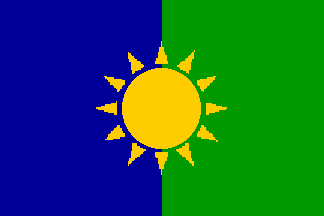
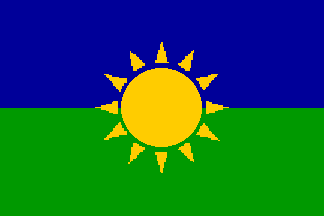
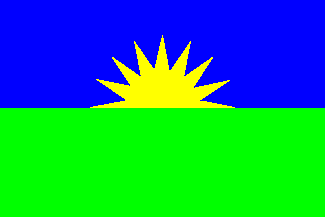

Last modified: 2022-04-16 by bruce berry
Keywords: rwanda | r | pan-african colors |
Links: FOTW homepage |
search |
disclaimer and copyright |
write us |
mirrors
![[Rwanda]](../images/r/rw-1962.gif)
In Rabbow's 'dtv-Lexikon politischer Symbole', (1970), it states that
"the original red-yellow-green flag in the form of the republican tricolour
was introduced when the Republic of Ruanda was proclaimed on 21-1-1961.
It appeared that this flag was identical with the flag of Guinea, so the
'R' was inserted in 1962 for 'R(uanda), born through R(evolution), confirmed
by R(eferendum)'. The Pan-African colours symbolise: red - the shedding of
blood and the suffering during the people's liberation (that is, the Hutus);
yellow - rest and peace of a free people; green - hope and trust.
Jarig Bakker, 05 Jun 1999
We have the adoption date for the Rwandan 'R' flag as 01 July 1962. Whitney
Smith [smi82] gives the official hoisting
date as "approximately September 1961". I guess that 01 July 1962 is the
official adoption of the legislation that confirmed the addition of the
letter R in the flag that was done already in practice previous September.
Željko Heimer, 29 Dec 2000
In Album 2000 one can find: the Old
National Flag. CSW/--- 2:3
Vertical tricolour of red-yellow-green with black letter R in the middle.
The image is no surprise, but could do handy instead of the 1996 image
I made with the technology (and know-how) of the time. However, the Album
2000 image has letter pictured thinner (or more elegant, if you wish) then
in other representations I encountered. The simple typeface used here is
usually called Gothic or Futura family. Of course, the exact shape and
size of the letter was never officially prescribed and therefore we should
not insist in describing differences in various sources. Something simple
as above would surely be among the most popular choices.
Željko Heimer, 30 Dec 2000
"The New Times", from Kigali, the capital city of
Rwanda, reported on 26 March 2006, reports that the old national flag of Rwanda
is sometimes still used in international events, in spite of having been
superseded in 2001.
Recently, a cultural group from Rwanda won the first prize in an international
folklore competition held in Sicily, Italy. During the official ceremony, the
old flag was raised. Fortunately, the Rwandans could quickly provide the current
flag. The article further says that the former national anthem is also often
played in international events. (Source: http://allafrica.com/stories/200603270487.html)
Ivan Sache, 29 Mar 2006
![[Rwanda]](../images/r/rw-1961.gif)
It is not at all clear from sources if the first Rwandan flag was red, yellow, green or green, yellow, red!
William Crampton mentions in his book named "Flags & Coat of Arms" (1985) [mch85a] that Rwanda's tricolor in the Pan-African colours with vertical stripes of red, yellow and green was established in 1961 and later that year a black letter "R" was added in the centre of the flag to distinguish the flag of Rwanda from that of Guinea. The similar description is given by Dr. Whitney Smith [smi75c].
However, William Crampton amended his above text in his book named "The World of Flags - A Pictorial History" (1990) [cra90] that the first flag of Rwanda was introduced by PARMEHUTU on 28 January 1961 and was simple vertical tricolor of green, yellow, red - however this turned out to be identical with the flag of Mali, once this country had removed the Kanga (black outline of a man) from its flag (01 March 1961) and a large black "R" was added to the centre and that in September 1961 the flag was altered so that the red and green changed places.
I believe Crampton's own correction because the Guinean flag was introduced in 1958 and Rwandan people could not have know that flag as one of New African leader's flag and at that time simple green, yellow, red vertical flag had not been used by any other African nation to my best knowledge. How could they copy Guinean flag for their national flag ?
I assume that it was quite amazing for Rwanda political leaders to learn
that Mali changed their flag on 1 March 1961, just two months after Rwanda
first flag introduction. And they had to distinguish their flag from most
similar flag (Guinean) as well then just put "R" in reverse tricolour which
makes it the only one in existing national flag with the country's initial.
Nozomi Kariyasu , 01 Feb 2001
The former South African homeland of Venda also had
its initial on its flag which was used between 1973 and 1994.
Bruce Berry, 01 Feb 2001
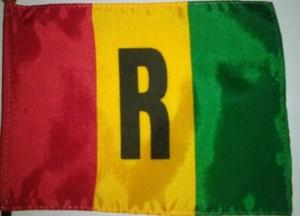
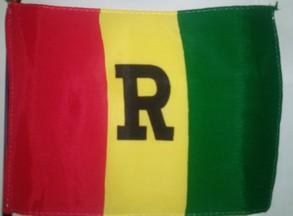 images sent by Blinxcat, 20 Mar 2022
images sent by Blinxcat, 20 Mar 2022In Whitney Smith's "Flag and Arms Across
the World" [smi80], the Croatian
edition dated 1982, the 'R' is shown in
san serif.
Željko Heimer, 19 September 1995
It is also san serif in the English edition. It is also san serif in Flags
[ale92] by Kent Alexander [maybe not surprising as Whitney Smith
was the consulting
editor] and in Flags of the World
[cra90i] by William Crampton.
Stuart Notholt, 19 Sep 1995
In a documentary about Rwanda on the ABC in Australia in September 1995 there
was footage of the former (assassinated) Rwandan President taking
the Presidential Oath of Office. He was standing next to a silk Rwandan flag
with the
'R' again being in sans serif.
Later in the same documentary the Rwandan Ambassador to the UN was shown at some UN meeting.
The flag in front of him had a serifed 'R'.
I suspect that there is probably no explicit definition of the exact
size, style and internal dimensions of the 'R', hence the variation we
see. However, it would seem the sans serif 'R' is used more often, and if
used at a Presidential swearing-in, is probably the closest we're going to get
to an official standard although other fonts for the 'R' have also been used.
Brendan Jones, 20 Sep 1995
What does the reverse of the Rwandan flag looks like? Is the letter
R mirrored?
António Martins, 02 Feb 2000
I believe that I read some time ago that it is not prescribed anywhere,
and is usually seen on the reverse backwards and only the more
expensive ceremonial flags are made double-sided.
Željko Heimer, 05 Feb 2000
KIGALI, May 18 1999 (Reuters) - The Rwandan government said on Tuesday it would introduce a new flag, coat of arms and national anthem because the old symbols carried echoes of a 1994 genocide. Officials said the red, yellow and green flag, with a capital R in its centre, was seen as a symbol of the previous Hutu-dominated government whose ideology lay behind the genocide, in which 800,000 Tutsis and moderate Hutus perished. It will be replaced by a red, white and green flag with a new coat of arms in its centre, showing an ear of sorghum, a wreath and a bird.
The old coat of arms, showing a hoe, a bow and arrow and a sickle, carried unfortunate echoes of the crude weapons used to carry out the genocide.
"We judged it necessary to change the national flag, the anthem and the coat of arms to bury the divisive past and foster national unity and reconciliation," Rwanda's Local Government Minister Desire Nyandwi told Reuters.
The Tutsi minority dominated the country before and during the era of Belgian colonial rule, but Hutus held power from independence in 1962 until 1994, when Tutsi rebels took power to end the genocide. The old national anthem celebrated a long Hutu struggle under Tutsi "oppression" while the red in the old flag symbolised the blood of Hutus killed in that struggle. "In public ceremonies... half of Rwandans prefer not to sing the anthem because it is perceived as thrusting the knife into the wounds," one official said.
In the new flag, red will symbolise the blood of all Rwandans, including
those killed in the genocide, white will stand for transparency and justice
and green will represent hoped-for prosperity. The government also intends
to replace street names commemorating Hutu heroes who it says killed Tutsis.
It will also rename Kigali's international airport, which is named after
the country's first Hutu president Gregoire Kayibanda.
Located by Jan Oscar Engene, 19 May 1999
A Reuters report on CNN ran:
Rwanda adopts new flag to bury genocide memories
KIGALI, 01 October 1999 (Reuters) -- Rwanda adopted a new national flag and motto on Friday because the old ones carried echoes of the 1994 genocide. The motto "Unity, Work, Patriotism" replaced "Liberty, Co-operation, Progress" which had been the motto of the central African nation since independence from Belgium in 1962, state-run Radio Rwanda reported. The new flag is mainly blue and green and features a sunrise. It replaces a red, yellow and green flag with a capital R in the centre. The old flag and other national symbols were seen as representing the previous Hutu-dominated government whose ideology lay behind the genocide in which 800,000 Tutsis and moderate Hutus perished. The Tutsi minority dominated the country before and during colonial rule, but after independence Hutus held power until Tutsi rebels overthrew the government to end the genocide in 1994. "It was high time we carried out these changes for not all sections of Rwandans were identifying themselves with the flag... which was a eulogy to the Hutu supremacy," a government official told Reuters.
Source:
http://www.cnn.com/WORLD/africa/9910/01/BC-RWANDA-FLAG.reut/index.html
Web posted at: 10:30 AM EDT (1430 GMT), 1 October 1999
Located by Mark Sensen, 02 Oct 1999.
I just received the following message from Dr. Whitney Smith of the Flag Research Center:
The news report from Reuters about a new national flag having been adopted
by Rwanda on 1 October was incorrect. I checked with my direct sources
in Rwanda who report that the Cabinet on 30 September decided to propose
a flag change. The bill must be drafted, presented to the national assembly,
and passed by a three-quarters vote since it involves an amendment to the
Constitution. It must then be cleared by the Constitutional Court, signed
by the President, and published in the official gazette before Rwanda has
a new flag.
Dave Martucci, 04 Oct 1999
 |
 |
 |
| Dylan Crawfoot | Dylan Crawfoot | Robert Wheelock |
If my memory is correct, the Tutsi Patriotic Front flag is blue over
green while Hutu MDR Party's colour is red, black, green and yellow - namely
the previous colours of the national flag plus black.
Nozomi Kariyasu, 27 Oct 1999
Rwanda has still not settled for a new design to replace its current national flag, it seems. The Africanews web site carried a report from the Nairobi newspaper The East African in which it is reported that the Rwandan government has announced an international competition to find a new flag for the country. As usual, a news report like this much be taken with a few pinches of salt. Anyway, vexillographers should mind the "guidelines", the favoured colours are yellow, green and sky blue, and the designs should feature a rising sun.
Quoting from the website:
"In a notice to bidders for the competition, the Minister for Local government,
Mr. Desire Nyandwi specifically points out that the flag must symbolise
national unity, respect for work, heroism and confidence in the future.
The government wants the flag to have the colours yellow, green and sky
blue in it with the rays of the rising sun shining through."
Jan Oskar Engene, 6 Dec 1999
A piece of news at
this
webpage
We're sorry, say Rwanda genocide leaders
RWANDA'S main political party, which incited Hutus to slaughter their
Tutsi neighbours, has asked for forgiveness for its role in the 1994 genocide.
"The MDR asks for forgiveness from all Rwandans for the divisive campaign
propagated by some of its leaders, which became the basis of the Hutu 'power'
and which led to the 1994 genocide," says the party's new chairman, Pierre
Celestin Rwigema. Rwigema, who held a news conference in the Rwandan capital
of Kigali at the weekend, says they have began reforming the Mouvement
Democratique Republicain (MDR) since the murderers lost power in the tiny
Central African country in 1994.The reform includes the changing of the
party's flag from red-black, which reinforced the Hutu supremacy, into
red-green. "The 'green' epitomises hope for a reconciled and unified Rwanda.
While the 'red' represents the Tutsi and Hutu blood," he explains.
Source: Daily Mail & Guardian
(South Africa), April 15, 1999
So there was [maybe] a flag-change after all... that of the MDR.
Jarig Bakker, 15 Jan 2000
Last week a French minister visited Kigali ; on this occasion TV report
showed that Rwanda still uses its unchanged national flag with black R
in the yellow.
Armand Noel du Payrat, 01 Feb 2000
A week ago I asked Embassy of Rwanda in Tokyo about the new flag. They
say they still use r-y-v with R flag since the government is still in process
to decide new flag. I asked them whether the new flag is somehow blue over
green with sunburst and they were surprised that I know the basic design
which they received as one of proposals from Kigali.
Nozomi Kariyasu, 15 Sep 2000




